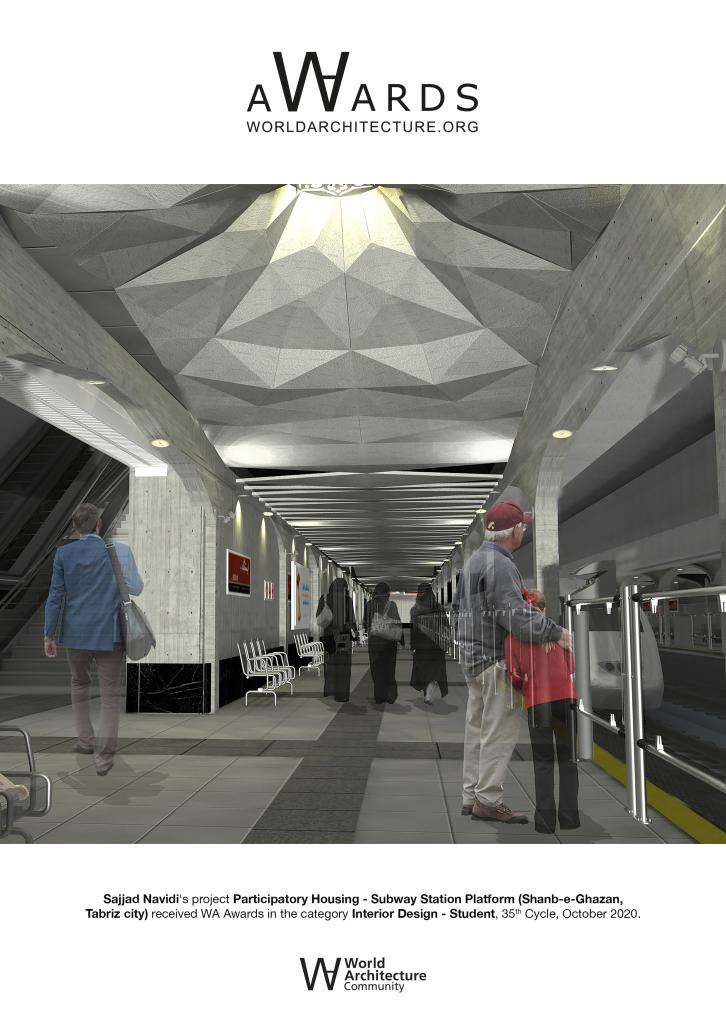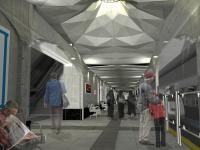The Tabriz Metro Line 2 station is located in the historic district of Shanb-e-Ghazan. For this reason, this historic site was of great importance in the design of the station platform.
The historic district of Shanb-e-Ghazan:
Shanb-e-Ghazan is one of the historical neighborhoods of Tabriz, Iran. Shanb-e-Ghazan historical importance is mostly due to construction of a palace which later turned to the thumb / mausoleum of Ghazan Khan, the Ilkhanid emperor in late 13 and early 14th century.
At the time of king Mahmud Ghazan, Ghazan Khan, Shanb-e-Ghazan is evolved into a large satellite city of Tabriz called Ghazaniya. The neighborhood reached to its most prosperity at this time.
In late 1297 Ghazan Khan built his unique Tomb called Qubba-ye-Aali (Big Dome) in central part of the town and as he was interested a lot in benevolence, he ordered to build twelve charity building on all twelve sides of this building which consisted of : Jami Mosque, Khanqah, Hanafiyah School, Shafi'iyah School, Dar Al Siyadah, Observatory, Hospital, Library, Beit Al Qanun, Beit Al Motavalli, pool house, and Bathroom. There were other buildings such as orphanage, and Hakimiyya around this building.
The earthquakes of 1641, 1650, and 1721 destroyed Shanb-e-Ghazan and its buildings a lot and miniaturized its residential area. The earthquake of the first morning of 1780 buried the remaining buildings. Thus from Ghazaniyyah just the south east part of it has been remained.
Shanb-e-Ghazan's antiquities because of the inadvertence of Qajar and Pahlavi government has been despoiled and it has led to this point that nowadays in this historical neighborhood there are no historical remains except for a bathroom and some scattered tiles.
Light
Light in traditional architecture was used as a decorative component in addition to its role in providing space lighting, and other building decorations were also used to enhance the role of light in architecture. In traditional Iranian architecture, light is not defined equally for all spaces, and the amount of light appropriate to each space depends on the need and function of that space in architecture.
The light in traditional bazars was such that, in addition to illuminating the interiors of the bazar, it marked the direction of the movement of people towards the market. Also, at the intersection between the corridors of the bazars, there was a space called the (Charsouq). Above (Charsouq), (Horn), which shines light beneath the dome, making that boring space vibrant and dynamic by creating pause and discourse.
One of the most valuable examples of the use of (Horno) can be found in the Tabriz bazar, one of the historic and most important traditional Iranian bazars.
Design process
Interiors Most subway platforms in Iran have dead spaces with boring corridors because of their underground location. These spaces encourage travelers to get off to the ground faster.
Due to the limited space of the subway platforms, we had to look for a solution on the roof. Due to the high importance of the historic district of Shanb-e-Ghazan in the design, we were inspired by one of the most important tiles left over from that time, and by expanding the geometry of the tile layout we created dome-like structures at the entrances to the subway platforms, such as (Horno) in traditional bazar architecture. From inside, we shone a light underneath the dome that is reminiscent of the Shanb-e-Ghazan 's historical era, and in this way created the pauses and discourses that were reminiscent of its past architecture and encouraged people to think about their past.
2017
0000
Location: Shanb-e-Ghazan, Tabriz city, Iran
Wall material: Reinforced concrete
Sajjad Navidi
Subway Station Platform (Shanb-e-Ghazan, Tabriz city, Iran) by Sajjad Navidi in Iran won the WA Award Cycle 35. Please find below the WA Award poster for this project.

Downloaded 6 times.
Favorited 4 times













